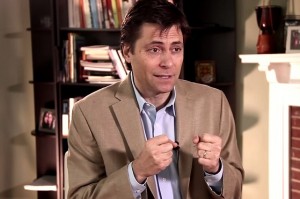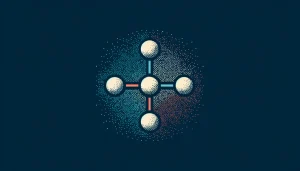Our Mathematical Universe
Physicist Max Tegmark on the Doppler effect, redshift, nuclear fusion, and what happened 13.8 billion years ag...

Markus Morgenstern is Professor of Physics and the Director of the 2nd Institute of Physics B at RWTH Aachen University. Serious Science has asked Prof. Morgenstern to speak on the subject of weak topological insulators and 2D materials.
What is your laboratory working on?
Basically, my laboratory is focused on scanning tunneling microscopy. In order to explore novel properties, we do scanning tunneling microscopy at very low temperatures and in high magnetic fields.We add up the possibility to measure transport directly in the microscope and we work on time resolved STM. We also try to advance the electronic readout of the tip by bringing the tip directly on a chip. On the other hand, we investigate different kinds of materials like graphene, topological insulators, semiconductor samples, and phase-change materials. Central to our research is the use of the instrumental development to get some insight into the properties of electronically relevant materials at the atomic scale.
One of your recent developments is weak topological insulators. Could you please tell me more about them: what are their structure and properties, how you develop them and so on?
The field of topological description of materials was kind of reinvented about 10 years ago. If you look at three-dimensional materials, there are two general non-trivial classifications: one describes the celebrated strong topological insulators where you can be sure to have surface states on all surfaces. For weak topological insulators you necessarily have surface states on most surfaces, but there is one pair of surfaces, which does not

have surface states – the so-called ‘dark surface’. This is actually an advantage, because if you somehow make a step-edge on that dark surface, its edge necessarily belongs to the bright surfaces. So, if you have a step-edge, then you get a one-dimensional channel of conducting electrons for free. If you can make step-edges on a surface, you create a traveling path for electrons, which will profit from the fact that electrons in topological states cannot be backscattered, such that the step edges are ideal conductors. In principle, one can make an ideal conducting channel along a designed path by just scratching the surface. We collaborate with chemists from Dresden who created the first material which should show these weak topological properties as deduced just from the computer analysis. We received these samples from our colleagues in Dresden and attested that the edge states are indeed there.
That’s what we did so far and now we’re moving towards using these edge states for transport after creating them by scratching. One of the remaining problems is that currently the edge states are not at the Fermi level, so they are within the occupied states. For transport, we have to bring them to the Fermi level. By chemical analysis, we know now that this is just a problem with the surface itself. Basically, it’s a layered ionic system and you just remove the anionic layer from the cationic layer changing the charge state of the cationic layer. So, we have to compensate for that, and this is what we are currently trying to do.
Could you please elaborate on the question of their structure? You have mentioned the anionic layer and the cationic layer, so what are they made of? What materials are involved?
It’s a complex structure made of bismuth, rhodium and iodide in 14-3-9 stoichiometry. But you can understand it rather easily by looking at the symmetry patterns. Basically, you have a graphene-like layer, a honeycomb structure, and on top you have a zigzag chain layer. The honeycomb structure is made of bismuth, rhodium and iodine, while the zigzag chains are just made of bismuth and iodine. Think about a graphene-like layer, which is a two-dimensional topological insulator, made out of bismuth-iodine cubes refined by rhodium atoms, so it’s a little more complex and detailed, but in the end it’s just a honeycomb structure made out of heavy atoms. In between the honeycomb layers, you find the layers of zigzag chains being trivially insulating layers.
What properties do they have? How does it work and for what can one use that?
It’s too early to really say what it will be used for in the end. Typically, a one-dimensional channel is not conducting due to the strong backscattering in one dimension. So, basically, if you scatter back from a defect, then you go 180 degrees back.That leads always to localization in one-dimensional systems, so conventional one-dimensional systems can never be used for long-range electron transport. The only possibility is to have a very short piece of a one-dimensional wire, which is shorter than the scattering length. That’s different now with the topological systems, because they have an additional spin texture, which is spin helical. This spin helicity prohibits backscattering by an interference effect. Thus you can make a one-dimensional system conducting at large length scales. With that in mind, one can dream about different applications like making interference devices or making channels between quantum devices, which are connected by these particular channels – up to very strange ideas, i.e. you can make these channels containing Majorana fermions, if you put a superconductor on top, which can be used in quantum computation. But this is still far ahead, so basically we didn’t really elaborate on the question of how we implement such things in detail. We have these possible applications somehow in the back of our minds.
What was the previous research on topological insulators and weak topological insulators?
Weak topological insulators are a new field in experimental physics. It started in 2007 with a theoretical work which predicted that it could happen. Then there were a number of DFT studies, so theory proposed some materials which, however, have never been realized or not been shown to be a weak topological insulator except the one we have probed. This is the current status of weak topological insulators.
The field of strong topology started with two-dimensional topological insulators in the group of Laurens Molenkamp in Würzburg, where it became clear that the concept works, i.e. you have channels at the edge of HgTe samples, where you get spin-polarized transport. It is not quite clear so far why these channels are not perfectly quantized in terms of conductance, so there is still some deviation from e^2/h – what you expect as a conductivity. There is still ongoing research trying to understand that. There are also many efforts to combine this kind of channels with magnetic materials or with superconducting materials in order to get more collective behavior of the corresponding channels.
That’s 2D materials. The 3D materials are the biggest group at the moment concerning the number of scientists, as well as the number of materials – so it’s a list of 50 to 80 materials which show these 3D strong topological properties. In the 2D topological insulators it’s two only, in weak topological insulators it’s only one.
People are still looking for a way to optimize these 3D materials. Basically the surface states are approved, but what you would like to have in addition is that the material’s bulk is truly insulating. And so far best materials are still at the borderline. For a long time they were much too disordered in terms of potential fluctuations, so that you always had some electron puddles or hole puddles in the bulk giving you some conductivity.People worked a lot on optimizing that by alloying the material, by stacking the material in pn junctions, by gating the materials, or by optimizing the growth procedures using chemical vapor deposition, molecular beam epitaxy and so on. So that’s, I think, the main line for the strong topological insulators. And then there are other things like exploring the spin transport on these materials, i.e. people which originally come from the spin transport area joined the field and started to use some fancy tricks in order to get spins into the system, like, for example, ferromagnetic resonance, which is called ‘spin pumping’. They found very promising spin injection rates, so the materials are good spin conductors, but still it is not perfectly clear whether spin conduction is on the surface or if the bulk is still contributing.
And then there is the branch of Majorana fermions. This is a bit independent from the main lines of topological insulator research, but it’s also a topological property – Majorana fermions can be described by a topological number. They are special, because they are only half fermions, so they are an emerging particle from the sea of electrons under particular conditions. There is a huge amount of theory about that topic, and there is a number of experiments realizing it, for example, in InSb wires which are in contact with superconductors and which are exposed to an additional magnetic field. So it is a rather fancy and difficult experiment, where some signatures have been seen which are probably caused by the half-fermion. This is interesting in terms of topological quantum computation.
The whole topic of topology in solids is still a growing field. We now have a much better idea how to use the topological description in order to pinpoint relevant properties of materials, but still new people are joining the novel field and try to bring in their special expertise.
Apart from these topological insulators what other research in the field of materials do you do?
In addition to topological insulators, we are a part of the graphene flagship, which is a rather strong European initiative to bring graphene and other two-dimensional materials into products. I am on the far fundamental side of this initiative consisting of about 200 different research groups in Europe. One aspect is graphene, but we are now moving towards other two-dimensional materials, like two-dimensional semiconductors, insulators etc. This is a rapidly growing field where many different materials have been found to be real 2D, i.e. just one atomic layer thick.What is particularly exciting is that you can staple them: you can put one 2D material on top of the other such that you can probably design materials properties, which are impossible for conventional 3D crystals. If you think about having a graphene layer, and then an insulating boron nitride layer, and then molybdenum disulphide, and when you restart this sequence from the beginning on top, it might give you very different properties from the materials that we know nowadays.
Why did this interest in 2D materials explode?
It is a wide field. There are real applications: as you might know, graphene is already related to some products on the market as, e.g. electronic ink. There are anticipated applications which trigger that field: in particular, if you use the 2D materials, then you can make all the devices in a flexible form, which has been done so far with polymers, but polymers have very bad conductance. These materials have much better conductance and you can build detectors and transistors out of it, always with the advantage that it is really bendable, so you can think about all kinds of bendable electronics. That’s triggering very strongly.
There is also a very strong field trying to use these materials in electrodes of batteries, so basically making faster batteries – called supercapacitors – a business which is testing very strongly combinations of novel 2D materials. Many people thought in the beginning that graphene might be a solution, because it is very thin, but meanwhile we know that the number of ions you can put there is much too low, it doesn’t help you, but combinations of materials still look promising. This is not really stapling them, but mixing them, and then rely on a natural kind of stapling in the materials.

There is also a very promising area with respect to filter techniques. I am not an expert there, but for me it is very plausible that if you have an atomically thin filter then you can filter much faster. At the moment you have mostly bulky polymers and ceramics which are several nanometers thick, and if you would like to filter you will need to press the molecules through the whole material. If it just a single layer – it is different: If a 2D material survives the required pressure, it will go much faster.
There are many things that were done, not by us, but by other people, trying to optimize this filter process.And then, of course, a huge amount of different 2D materials gives you different filter properties for different molecules because of the interaction of the molecule with the material itself.
These are some of the driving forces of the field 2D materials.
What is the future of the field of 2D materials and of weak topological insulator research?
With 2D materials it is very difficult to say. I am sure that there will be some applications, but I am also sure that if I tell you one application it will not be the right one, as it always is. A lot of these questions are about costs, about production quality and things like that that you don’t know from the beginning. But I am sure that they will be applied one way or another.
Concerning the weak topological insulators it is much more on the fundamental side. One can talk about devices, but at the moment it’s devices for the lab where you show some novel effects, and not something which is robust at room temperature as required for many real-world applications.
What future studies can be done based on what we know now and what we need to know further?
With 2D materials it is rather clear. What is very important with them is to optimize them. The community has done that now for graphene. For graphene we have relatively cheap and well-developed methods to produce huge amounts of high-quality material which are already sold in factories. However, for the other new 2D materials that’s not the case: compared to graphene they still have lousy quality, and we just have to go the same path in terms of optimizing the quality, of finding out what is reducing the quality, what are the decisive defects and so on.
In the field of topology, I would say we are just beginning to appreciate this new concept of understanding materials by this very mathematical idea of topological indices. It is very abstract in terms of complete and transparent understanding, but its predictions turn out to be extremely robust, because at the end of the day you can clearly distinguish 1 from 0, and there is no way to continuously transfer between these numbers by integers – they are just different making the related properties of materials very robust. There are many proposals in the literature of other topological indices which have to be realized in experiment. But I believe that even the theoretical exploration is far from being at the end such that one cannot predict now what this new approach of topology will bring us.

Physicist Max Tegmark on the Doppler effect, redshift, nuclear fusion, and what happened 13.8 billion years ag...

MIT Professor Seth Lloyd on the origin of life, the butterfly effect, and the Universe as a quantum computer

Combination of nanotechnology and scanning tunneling microscopy offers the prospect of dramatically improving ...